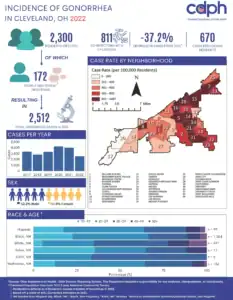By Ron Calhoun
A new report from
Frances Mills, commissioner of health, City of Cleveland Health Department, shows that sexually transmitted infections, or STIs, remains a serious health problem in Cleveland. Nearly
8,000 people were diagnosed with chlamydia, gonorrhea, or syphilis.
Health experts say some numbers have gone down, but one infection, syphilis, keeps going up. They warn that the increase indicates Cleveland needs more testing, treatment, and education about sexual health.
Chlamydia Still the Most Common Infection
Chlamydia was the most common STI in Cleveland in 2022, with 4,396 people infected and 4,885 total cases. That means some residents were infected more than once. Even though the number of chlamydia cases went down about 13% from 2021, Cleveland still has one of the highest infection rates in the country. There were 1,303 cases for every 100,000 residents, which is almost three times higher than the national average, according to the department’s 2022 chlamydia Infographic.
Fewer Gonorrhea Cases, But Still Widespread
The number of people with gonorrhea dropped by 37% in 2022. There were 2,512 total cases among 2,300 residents. That’s an improvement, but the infection rate, 670 cases per 100,000 residents, is still very high.
Doctors say many people have both chlamydia and gonorrhea at the same time. In 2022, there were 811 co-infections, showing that these two diseases often occur together.
Syphilis Keeps Rising
While chlamydia and gonorrhea went down, cases of syphilis went up. In 2022, the city recorded 466 total cases, a 4% increase from 2021. Health officials say this is part of a five-year trend. The number of people with syphilis has grown every year since 2018, especially among young adults and men.
Who Is Most Affected
Black residents in Cleveland are affected by STIs more than any other group. Between 2017 and 2021, they made up more than 70 % of all cases. Experts say this is due to bigger issues, like limited access to healthcare, higher poverty rates, and a lack of testing sites in some neighborhoods.
Women, are more likely to get chlamydia, while men are more likely to get gonorrhea or syphilis. In 2022, three out of four syphilis cases were in men.
The people getting sick are often ages 15 to 29. Health officials say this shows that young people need more information about safe sex and regular testing.
Repeat Infections and Hot Spots
Many Clevelanders are being infected more than once. In 2022, 428 people had repeat chlamydia infections, 172 had gonorrhea again, and 14 had syphilis more than once.
Maps from the Cleveland Department of Public Health show that the city’s East Side neighborhoods have the most cases. Areas such as Mount Pleasant, Glenville, Union-Miles Park, and Hough report the highest numbers every year.
These neighborhoods also face higher rates of poverty and fewer healthcare options, which experts say makes it harder for people to get help or testing.
The Link Between STIs and HIV
The city report shows that many people who get syphilis are also living with HIV, the virus that causes AIDS. About 4 out of 10 people diagnosed with syphilis were also HIV-positive.
More than half said they had been treated for another STI before, and some reported trading drugs for sex. Health workers say this shows how issues like addiction, homelessness, and lack of healthcare are all connected.
A Growing Concern for Women
Another worrying sign is the increase in syphilis among women, especially pregnant women. From 2017 to 2021, there were 10 cases of congenital syphilis, in which a baby was born infected.
Most of these cases involved Black or Hispanic mothers. Doctors warn that without more testing and prenatal care, those numbers could rise again if healthcare access remains limited.
What Cleveland Can Do
City officials say Cleveland must focus on education, prevention, and access to testing. They advocate for more clinics and community programs to help people learn about sexual health and get tested regularly.
“Education and access to care are key,” said a spokesperson for the Cleveland Department of Public Health. “The more people we can reach, the better chance we have to stop these infections from spreading.”
Experts say that while the city made some progress in lowering chlamydia and gonorrhea, the continued rise in syphilis shows there is still a lot of work to do.
Later this year, Cleveland’s next STI report will show whether the trend has changed. For now, health officials say one thing is clear: fighting these infections means talking about them openly , and making sure everyone has the chance to get tested and treated.
The Cleveland Observer remains committed to producing journalism that is accurate, community-centered, and reflective of Cleveland’s diverse voices. As part of our editorial workflow, this article was reviewed using the TCO Editorial Prompt AI Style Guide, a structured tool that supports clarity, fact-checking standards, community impact framing, sourcing, and overall readability. All recommendations generated by the AI are reviewed, verified, and approved by a human content provider before publication.
Human editors always make the final decisions.







